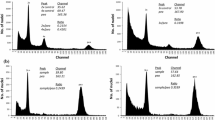Abstract
Since the discovery of the use of colchicine in plant breeding, breeders have created tetraploid sugar and fodder beet. The results obtained were not very encouraging and therefore they soon proceeded to develop varieties containing triploids.
At the Foundation for Agricultural Plant Breeding, Wageningen, polyploidy breeding was started in 1950. The initial material comprised two sugar beet varieties and five fodder beet varieties. By cytological examination of the aberrant individuals in the first and the second year after colchicine treatment, seed was obtained which produced a high percentage of tetraploids. In total 793 C2 families were tested on trial fields and from these 32% appeared to be better than the original diploid material.
The breeders interested in the material were provided with seed and stecklings of all the families in the C1, C2 or C3 stage. With the distribution of this material the building up of tetraploid families at the Foundation for Agricultural Plant Breeding has been closed.
Samenvatting
Sedert de ontdekking van de toepassingsmogelijkheden van eolchicine in de plantenveredeling zijn de kwekers begonnen met het tetraploid maken van suiker- en voederbieten. De verkregen resultaten waren niet erg hoopvol en reeds spoedig is men daarom overgegaan tot het creëren van rassen, waarin triploiden voorkomen.
De S.V.P. is in 1950 begonnen met de polyploidieveredeling van 2 suikerbieten en 5 voederbietenrassen. Door de afwijkende bieten in hun eerste en tweede levensjaar nauwkeurig cytologisch te onderzoeken werd zaad verkregen, waarin een hoog percentage tetraploiden voorkwam. In een éénjarige zaadteelt werd van de C1 bietenzaad geoogst, dat op het proefveld werd uitgezaaid.
In totaal werden 798 families in het C2 stadium onderzocht en hiervan bleek 32% beter te zijn dan de diploide uitgangsrassen. Van een jaargang werd van de beste families zaad op het proefveld uitgezaaid, het percentage van het aantal families, dat beter was dan het uitgangsmateriaal bleek iets groter.
Van de overige families werd ook zaad geoogst; zij kwamen in het stadium C3 iets slechter naar voren dan de beste families.
Aan de daarvoor in aanmerking komende kwekers zijn van alle families in het C1-, C2- of C3-stadium zaad en stekbieten afgestaan, waarmede de opbouw van de tetraploide rassen door de S.V.P. is afgesloten.
Similar content being viewed by others
References
Abegg, F. A., The induction of polyploidy in Beta vulgaris L. by colchicine treatment. Proc. Amer. Soc. Sugar Beet Technologists (Second General Meeting) (1940): 118–119.
Abegg, F. A., Stewart, D. and Coons, G. H., Further studies on sugar-beet autotetraploids. Proc. Amer. Soc. Sugar Beet Technologists (Fourth Gen. Meeting) (1946): 223–229.
Armstrong, J. M., Production and value of polyploid field roots. Scientific Agriculture 22 (1942): 787–798.
Ernould, L.,.l'Autopolyploidie expérimentale chez la betterave. Publications de l'Institute Belge pour l'Amélioration de la Betterave 14 (1946): 205–269.
Frandsen, K. J., Colchicininduzierte Polyploidie bei Beta vulgaris L. Der Züchter 11 (1939): 17–19.
Kloen, D. and Speckmann, G. J., The creation of tetraploid beets. Euphytica 2 (1953): 187–196; 3 (1954): 35–42; 154–160; 5 (1956): 308–322; 6 (1957): 193–197.
Knapp, E., The significance of polyploidy in sugar beet breeding. Proceedings of the International Genetics Symposia, Tokyo 1956: 300–304.
Peto, F. H. and Boyes, J. W., Comparison of diploid and triploid sugar beets. Can. J. Research C, 18 (1940): 273–282.
Peto, F. H. and Hill, K. W., Colchicine treatments of sugar beets and the yielding capacity of the resulting polyploids. Proc. Amer. Soc. Sugar Beet Technologists (Third Gen. Meeting-1942) (1943): 287–295.
Polyploidie der Rüben. Beiträge zur Rübenforschung. No. 1. Wissenschaftliche Abhandlungen, Akademie-Verlag, Berlin. No. 34, (1958): 68 pp.
Rasmusson, J., Autotetraploid sugar beets. Vitality changes in subsequent generations. Hereditas 39 (1953): 257–269.
Schlosser, L. A., Untersuchungen an autopolyploiden Zuckerrüben. I.Z. Wirtschaftsgr. Zuckerindustrie 90 (1940): 88–106.
Stewart, S., and Gaskill, J. O., Results of field tests with triploid sugar beets in 1951. Proc. Amer. Soc. Sugar Beet Technologists (Seventh Gen. Meeting) (1952): 452–453.
Author information
Authors and Affiliations
Rights and permissions
About this article
Cite this article
Kloen, D., Speckmann, G.J. The yielding capacity of tetraploid sugar and fodder beets. Euphytica 8, 29–36 (1959). https://doi.org/10.1007/BF00022086
Received:
Issue Date:
DOI: https://doi.org/10.1007/BF00022086



